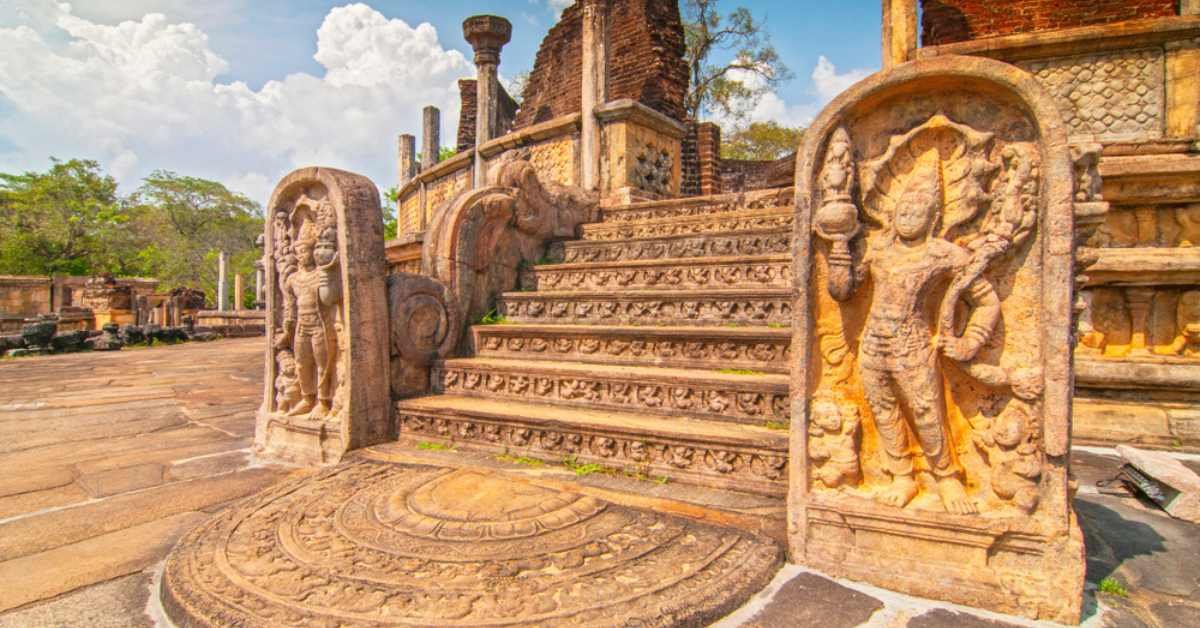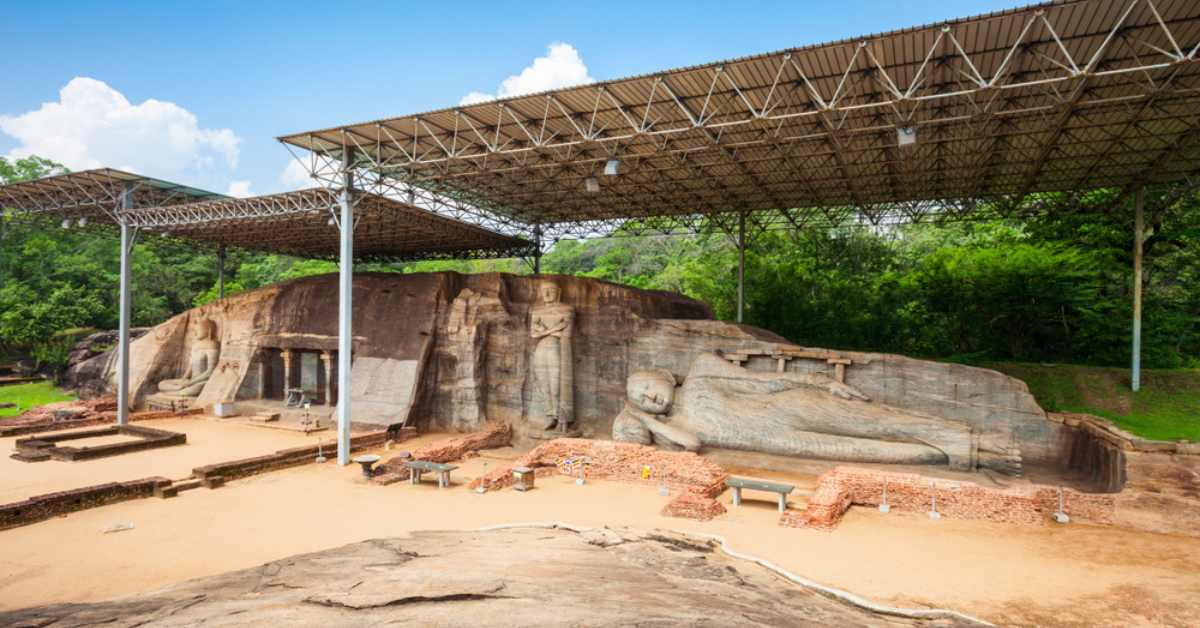
Nestled in the heart of Sri Lanka lies the captivating city of Polonnaruwa, a UNESCO World Heritage Site that takes us on a journey through the island’sisland’s rich history. With its well-preserved ruins, ancient temples, and stunning landscapes, Polonnaruwa offers a mesmerising glimpse into the past.
Origins and Foundation
The captivating city of Polonnaruwa, nestled in the heart of Sri Lanka, holds a history that traces back to the 10th century. During this time, King Vijayabahu I, a pivotal figure in Sri Lanka’s history, established Polonnaruwa as the island nation’s capital.
Under the reign of King Vijayabahu I, Polonnaruwa underwent a significant transformation. The city was renamed “Vijayarajapura,” signifying its newfound status as the capital. This move marked a monumental shift in power and governance, as Polonnaruwa took over the reins from Anuradhapura, the former capital of Sri Lanka.
With the establishment of Polonnaruwa as the capital, King Vijayabahu I solidified his position as the first Sinhala king of the Polonnaruwa Kingdom. His reign marked an era of change and growth, setting the stage for the city’s flourishing future.
To commemorate this historic moment, a grand coronation ceremony was held. The ceremony took place in a purposefully constructed palace for this event in Anuradhapura, the erstwhile capital of Sri Lanka. This palace served as a testament to the significance of the occasion and the establishment of Polonnaruwa as the new centre of power.
Polonnaruwa flourished as a centre of governance, trade, and culture with its newfound status. The city’s strategic location contributed to its prominence as a hub for trade and commerce. Merchants and traders from distant lands converged on its bustling streets, creating a vibrant marketplace that buzzed with activity.
Architectural Marvels Sacred Temples and Monuments
Polonnaruwa stands as a living testament to the architectural brilliance of ancient civilizations. The city’s landscape is adorned with architectural marvels that continue to captivate visitors worldwide. Each structure tells a story of craftsmanship, innovation, and a quest for aesthetic excellence. Explore our List of attractions in Polonnaruwa with a Map.
King Parakramabahu, the Great
One name shines brightly in the annals of Polonnaruwa’s history: King Parakramabahu I. His reign, spanning 33 years from 1153 to 1186 AD, stands as a testament to his greatness and his indelible impact on the entire island nation of Sri Lanka.
Under King Parakramabahu’s rule, Polonnaruwa experienced an era of unparalleled prosperity. His visionary leadership and strategic governance laid the foundation for a time of growth and development, not only for the city but for the entire kingdom.
One of King Parakramabahu’s most enduring legacies is the numerous architectural activities that flourished during his reign. The city transformed with remarkable structures and monuments that stand as awe-inspiring examples of ancient craftsmanship.
King Parakramabahu I enlisted the expertise of architects and technicians from India to realise his ambitious architectural endeavours. Their contributions and influence are still visible in the city’s well-preserved sites. The infusion of Indian architectural styles added a unique touch to Polonnaruwa’s landscape, showcasing a fusion of cultures. Polonnaruwa flourished culturally during the Chola occupation, indelibly influencing art, architecture, and language.
Rediscovery and Preservation
The story of Polonnaruwa’s rediscovery is a tale of historical intrigue and fascination. After centuries of obscurity, the city’s ruins were brought back into the spotlight, allowing the world to again marvel at its ancient wonders.
In the 19th century, Polonnaruwa’s ruins began to capture the attention of explorers, historians, and archaeologists. The overgrown vegetation that had concealed the city’s remnants was carefully cleared away, revealing the hidden architectural gems beneath.
As the layers of time were peeled back, Polonnaruwa’s historical significance became increasingly apparent. The rediscovery shed light on the city’s role as a thriving capital and a hub of cultural exchange, inviting researchers to delve into its mysteries.
The preservation of Polonnaruwa’s legacy stands as a testament to the determination of Sri Lanka to honour its history and share it with the world. Meticulous efforts have been undertaken to ensure that the city’s ancient structures remain intact for future generations to admire.
Sri Lanka’s commitment to preservation is evident in the meticulous restoration and conservation projects carried out within the city. Skilled artisans and experts have worked tirelessly to protect architectural wonders from the ravages of time.
Preservation efforts have not only focused on physical structures but also on the balance between modernity and tradition. Initiatives have been undertaken to educate visitors about the historical and cultural significance of the sites, fostering a sense of reverence and responsibility.
Current Population: A Glimpse into Local Life
Polonnaruwa, a city steeped in history and cultural heritage, is also home to a thriving modern population. As of the most recent estimates, the city’s population is approximately 14,000. This fusion of ancient legacy and contemporary life creates a dynamic, diverse atmosphere welcoming visitors and residents.
The city’s current population represents diverse backgrounds, cultures, and lifestyles. Residents coexist with the echoes of the past, creating a unique tapestry that reflects the city’s rich history while embracing the opportunities and challenges of the present.
From bustling markets and local eateries to schools and businesses, the city’s residents contribute to the vibrancy of Polonnaruwa’s everyday life. Much like the generations before them, this modern population shapes the city’s identity and ensures its continued growth.
As you explore the city’s historical sites and immerse yourself in its rich cultural offerings, remember that you’re not just stepping into the past but also experiencing Polonnaruwa’s present-day pulse. With its dreams, aspirations, and daily routines, the current population adds to the multifaceted charm that makes Polonnaruwa a genuinely captivating destination.
Best Time to Visit
When exploring the captivating city of Polonnaruwa, timing can make all the difference. The best time to visit this ancient wonder is during the dry season, from May to September. This period offers a delightful blend of pleasant weather and vibrant landscapes, making it an ideal window to experience the city’s historical treasures and modern charm.
During the dry season, Polonnaruwa enjoys moderate temperatures and lower humidity levels. This makes exploring the city’s ancient ruins and engaging in outdoor activities a comfortable and enjoyable experience.
One of the key advantages of visiting during the dry season is the reduced amount of rainfall. The risk of encountering heavy rains is significantly lower, ensuring that your plans to explore the city won’t be interrupted by weather-related inconveniences.
Despite its arid climate, Polonnaruwa’s landscapes flourish during the dry season. The lush greenery, blooming flowers, and picturesque surroundings create a visually stunning backdrop for your journey through history.
Plan your trip between May and September to make the most of your visit to Polonnaruwa. Whether you’re wandering through ancient ruins, cycling through historical sites, or immersing yourself in local culture, the dry season ensures that you’ll have optimal conditions for a memorable experience.
How to Reach
Polonnaruwa is easily accessible by various modes of transportation:
- By Air: The nearest international airport is Bandaranaike International Airport in Colombo. From there, you can take a domestic flight to Sigiriya Airport, approximately 68km ( 1.30 drive ) from Polonnaruwa.
- By Road: You can hire a private car, taxi, or public bus to reach Polonnaruwa from major cities like Colombo or Kandy. The journey offers picturesque views of the Sri Lankan countryside.
Accommodation Options
Polonnaruwa offers a range of accommodation options to suit different preferences and budgets Booking.com lists Many Accommodations in Polonnaruwa with your preferences.
Activities to Do
Embark on a journey through time as you explore the ancient ruins of Polonnaruwa. From the Gal Viharaya’s stunning Buddha statues to the grandeur of the Royal Palace, each site tells a story of a bygone era.
Rent a bicycle and pedal your way through Polonnaruwa’s historical sites. Cycling lets you leisurely explore the city’s treasures while enjoying the picturesque surroundings.
If you’re lucky to be in Polonnaruwa during a cultural festival, seize the opportunity to witness traditional dances, music performances, and local celebrations. These festivals offer a glimpse into the city’s vibrant heritage.
Polonnaruwa’s historical significance and its modern charm offer a unique travel experience. Whether exploring ancient ruins, soaking in local culture, or simply enjoying the scenic beauty, visiting Polonnaruwa promises to be a journey of discovery and wonder.

